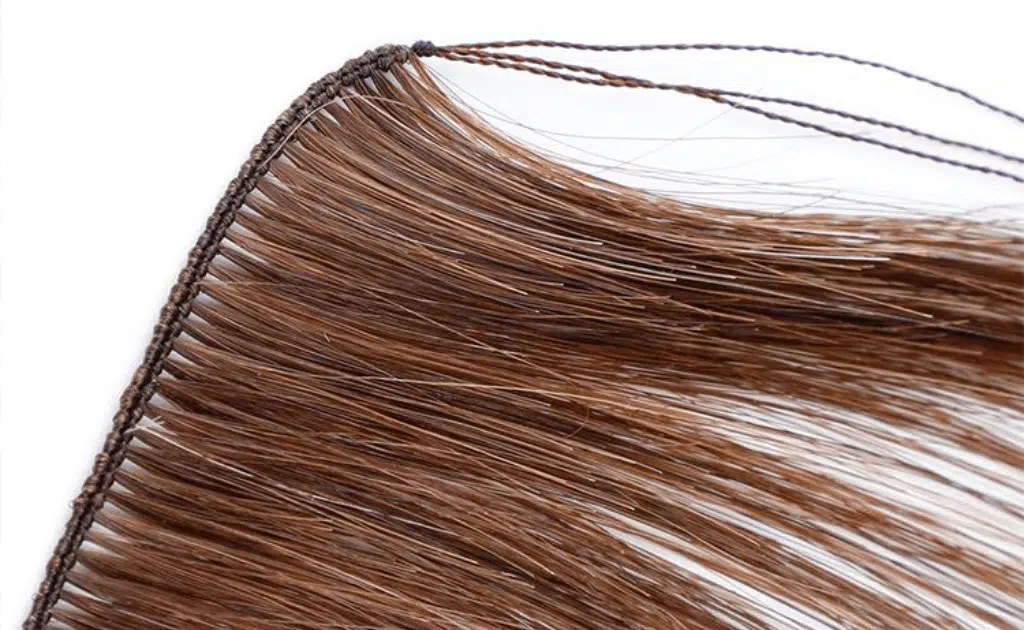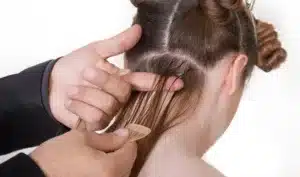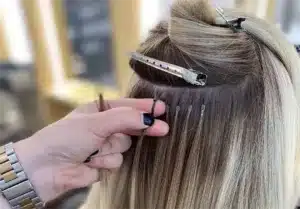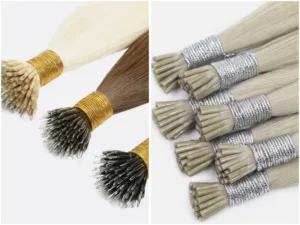Achieving a flawless blend between natural hair and extensions can be frustrating—especially when cheap weaves don’t match texture or density.
The best weave for blending natural hair is a full cuticle genius weft or hand-tied weft, matched with the right curl pattern, thickness, and length for your client’s real hair.

Getting the install right starts with understanding the hair quality, structure of the weft, and proper color + density matching. Let’s break it down for salon pros.
Why Does Full Cuticle Hair Matter?
Full cuticle hair solves the biggest pain point in blending—cheap hair mats, sheds, and won’t style like natural hair.
Only full cuticle hair, aligned root to tip, can mimic real hair in behavior and movement—making it ideal for seamless blending.
Dive Deeper: Why Quality Impacts Blendability
What Makes Full Cuticle Hair Different?
| Hair Type | Cuticle Aligned | Reusable | Styling Hold | Longevity |
|---|---|---|---|---|
| Non-Remy | ❌ No | ❌ No | Poor | 1–2 Months |
| Remy | ✅ Yes (partly) | ⚠️ Maybe | Medium | 4–6 Months |
| Full Cuticle Hair | ✅ Fully | ✅ Yes | Strong | 9–12 Months |
Full cuticle hair behaves like real hair. The strands lie in the same direction, reducing tangling and frizz. It blends better when straightened, curled, or dyed to match client needs.
This matters for both daily salon installs and e-commerce brands selling ready-to-wear units. If clients complain about extensions not blending or lasting, hair quality is likely the issue.
Why Are Genius Weft and Hand-Tied Wefts Best for Blending?
Blending is about more than hair quality—the weft construction also plays a major role. Flat, undetectable seams are the key.
Genius wefts and hand-tied wefts are the two leading weaves for natural blends due to their invisibility, density distribution, and flexibility.
Dive Deeper: What Sets These Weaves Apart?
Genius Weft
- No return hair (no short stubs)
- Machine-made, ultra-thin track
- Can be cut anywhere without unraveling
- Perfect for clients who want invisibility with custom placement

Hand-Tied Weft
- Manually tied wefts with ultra-thin seam
- Must not be cut; applied in full-width rows
- Soft and flexible
- Best for ultra-natural blends with consistent row installs

Compare with Other Weaves:
| Weft Type | Cuttable | Seam Thickness | Return Hair | Ideal Use |
|---|---|---|---|---|
| Genius Weft | ✅ Yes | Very Thin | ❌ None | Custom blend installs |
| Hand-Tied Weft | ❌ No | Thinnest | ✅ Yes | Full head installs |
| Machine Weft | ✅ Yes | Thick | ✅ Yes | High volume installs |
| Clip-In Weft | ✅ Yes | Medium | ✅ Yes | Temporary blends |
For long-term blending, only genius and hand-tied hold up without bulk or shedding. Most of our luxury salon partners in the US and UK use these two types exclusively.
How to Match the Right Weave to Client Hair?
The best weave won’t blend if it doesn’t match your client’s natural hair characteristics. Pay attention to color, length, curl pattern, and thickness.
Weave blending success starts with understanding the natural hair canvas.
Dive Deeper: Blend Factors You Can’t Ignore
Color Match
Even one level off in tone or undertone can ruin the blend. Natural black hair has red or ash undertones—choose accordingly. For custom installs, use lowlights or root shadows for depth.
Length Match
Length difference between real hair and weaves should be within 3–4 inches. Otherwise, it creates an obvious shelf. Blend with layering techniques or use staggered weft rows.
Curl or Wave Pattern
Match curl pattern carefully. At Hibiscus Hair, we offer custom curl patterns to match natural wave hair up to curly.
Density/Thickness
Match the thickness of the weft to the density of the natural hair. Too thick and the weave will bulge. Too thin and it will look sparse.
| Factor | What to Match | Why It Matters |
|---|---|---|
| Color | Level + Undertone | Ensures seamless visual transition |
| Length | Within 3–4 inches of real hair | Prevents sharp line of demarcation |
| Curl Pattern | Match curl type + pattern | Blends texture naturally |
| Thickness | Match bulk to hair volume | Keeps the install flush and invisible |
Blending is technical—but once matched right, even trained eyes can’t detect the extension line.

My Opinion
As a full cuticle hair manufacturer, I’ve seen too many salons lose clients because the weave just doesn’t blend. Not because of poor installation—but because of poor material selection. Blending starts at the factory level.
I recommend stylists never compromise on quality if blending is the goal. Choose full cuticle hair. Match the texture, color, and length precisely. And always pick genius or hand-tied wefts for clients who care about looking natural.
FAQ
What is the most invisible weave for blending natural hair?
Genius weft is the most invisible. It has no return hair, a flat seam, and can be cut freely—making it ideal for custom blends.
Is Remy hair enough for blending?
Remy hair is better than non-remy, but it still lacks the durability and consistent direction of full cuticle hair. For professional results, full cuticle is the best.
Can I blend weaves into short natural hair?
Yes, but the length gap should be small. Use layering and proper weft placement to prevent harsh lines between lengths.
How long does a properly blended weave last?
With full cuticle genius or hand-tied hair, you can expect the weave to last 9–12 months with 2–3 reinstallations.
Conclusion
What weave blends best with natural hair?Full cuticle grade of genius or hand-tied wefts, matched properly to client texture and density, are the best weaves for blending natural hair seamlessly.
where to buy weave hair extensions
Hibiscus Hair Manufacturer has been dedicated to producing high-quality weave hair extensions for 25 years and is a recognized leader in the industry. If you are interested in finding a reliable hair extensions supplier and wholesale for your brand, please visit our website for more information:
HAIR WEFT




